Routed West: Twentieth-Century African American Quilts in California
PDF: Potter, review of Routed West
Curated by: Elaine Y. Yau with Matthew Villar Miranda
Exhibition Schedule: Berkeley Art Museum and Pacific Film Archive, CA, June 8–November 30, 2025
Exhibition catalogue: Elaine Y. Yau, ed., Routed West: Twentieth-Century African American Quilts in California, exh. cat. DelMonico Books, 2025. 272 pp.; 280 color illus. Hardcover: $65.00 (ISBN: 9781636811598).
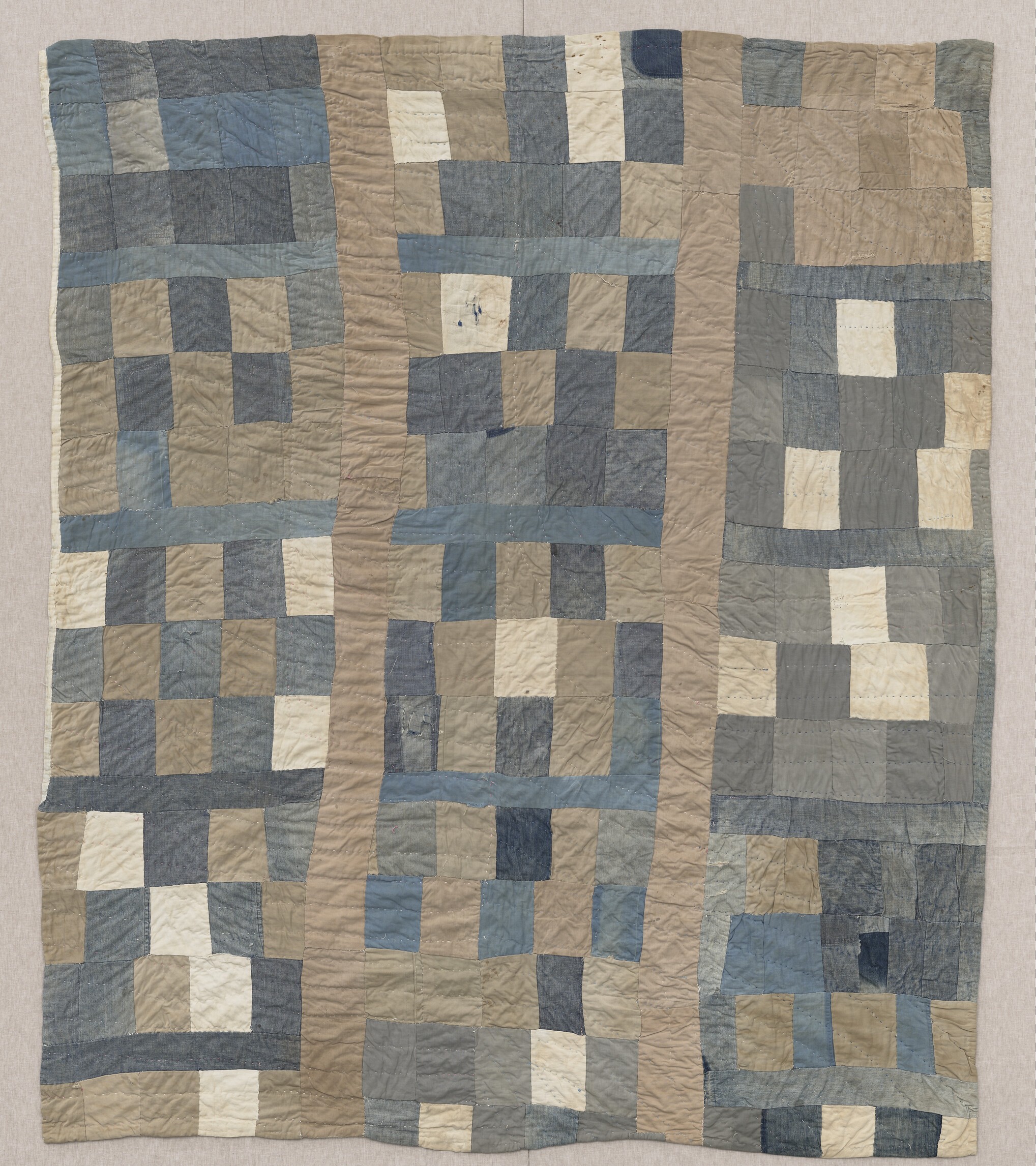
The exhibition Routed West: Twentieth-Century African American Quilts in California featured more than one hundred quilts by approximately eighty artists. It is the second of two exhibitions showcasing a bequest of nearly three thousand African American textile works donated to the Berkeley Art Museum and Pacific Film Archive (BAMPFA) at the University of California, Berkeley, in 2019. The collection is believed to be the largest of its kind and was assembled by Oakland, California, resident and self-taught quilt scholar Eli Leon. The first exhibition inspired by the bequest, Rosie Lee Tompkins: A Retrospective (February 19, 2020–July 18, 2021), presented seventy quilts by Tompkins (pseudonym for Effie Mae Howard; 1936–2006) and received international acclaim.
Routed West took a wider lens, charting the relationship between quilt-making traditions and the history of Black migration to California from the southern United States. Playing on the words “route” and “root,” the exhibition’s title evoked the movement of hundreds of thousands of African American families who left the South during the Second Great Migration in search of economic opportunities and freedom from racial violence. Quilts and quilt making migrated with the families who established roots in California, as seen in the nearly twenty-five quilts represented in the exhibition that were made in the South before 1950. The exhibition opened with maps of the southern United States and San Francisco Bay Area, marking the geographic locations of the quilts, which were described as “containers for ancestral memory, tethers to mothers and grandmothers, and emblems of cultural survival.”1 As the exhibition’s curator Elaine Yau points out, “This notion of rootedness . . . home place, of knowing where one’s origins are, is so much a part of African American quilt history in terms of the ways that quilts begin in the home.”2
Just after BAMPFA received Leon’s bequest, Yau was hired as the collection’s steward, and her work has involved cataloging, conserving, and researching the donation, which now comprises nearly one-fifth of BAMPFA’s total holdings. In 2024, Yau was promoted to the full-time position of associate curator and academic liaison at BAMPFA, and her new role is evidenced by the exhibition’s deliberate and innovative focus on collaboration and engagement. When I entered Routed West, a student gallery attendant kindly informed me that I was not allowed to touch the quilts but should interact with “touch labels” throughout the show. These special labels, as a wall text explained, offered physical samples of quilts created by the exhibition’s preparators and prompted visitors to “explore how certain quilts are made and how they feel” while protecting the collection on view. Each touch label highlighted a quilting pattern, technique, or material, like “summer spread,” “fan appliqué and ties,” or “denim and cotton sacks.” When the visitor pulled a sample away from the wall and held it, another wall text was revealed underneath, prompting reflection on how quilts are made and used.
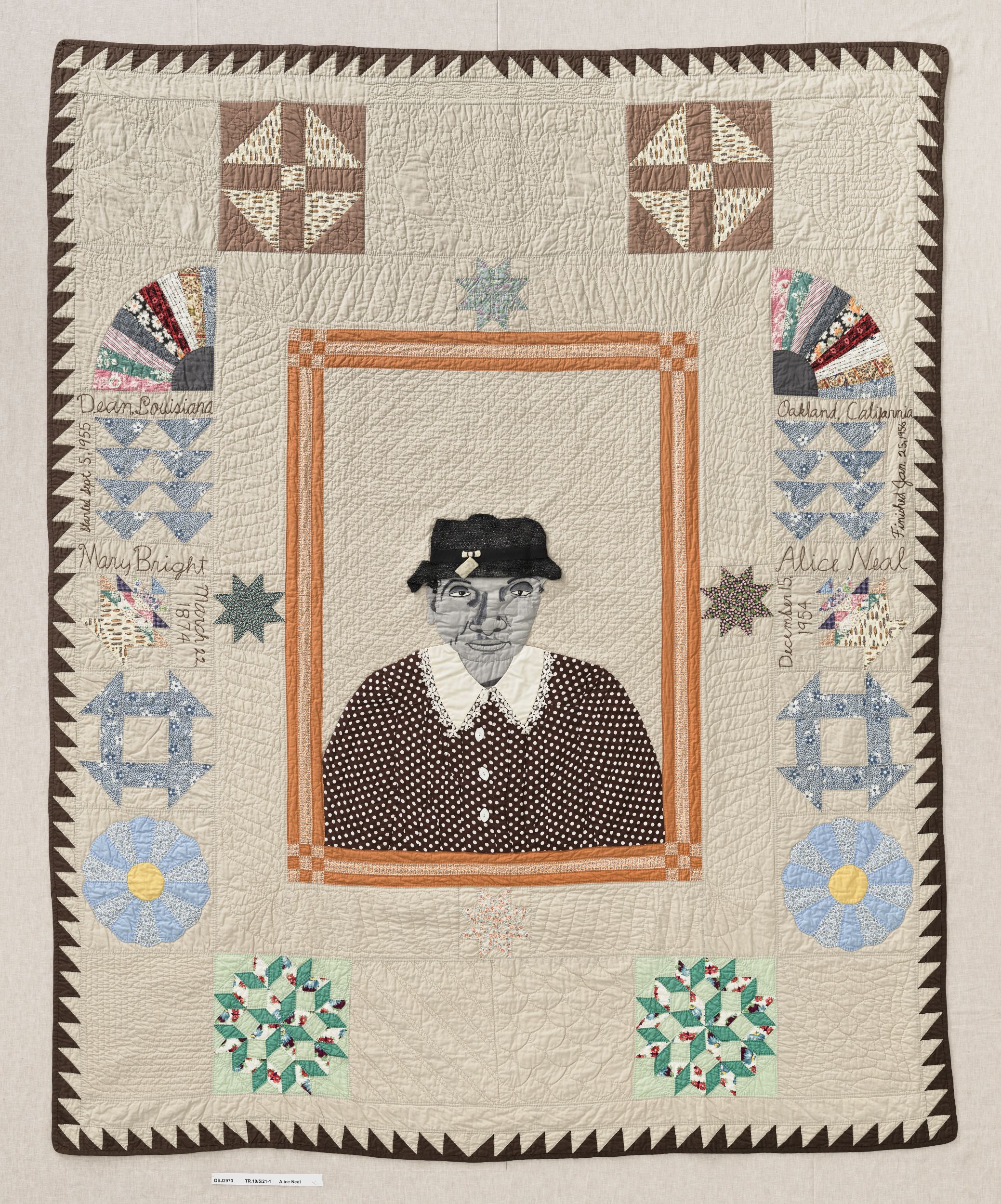
The touch labels seemed to respond to the opening lines of Sarah Hotchkiss’s review of Rosie Lee Tompkins: A Retrospective: “The most difficult thing about visiting the Rosie Lee Tompkins retrospective at the Berkeley Art Museum and Pacific Film Archive is maintaining self-restraint . . . the scintillating tactility of Tompkins’ work—70 dazzling pieces of textile art and assemblages—just begs to be embraced.”3 Unlike Joe Washington’s (1879–1963) Untitled (Fifteen Patch Variation) (fig. 1), a rich example of a work quilt comprised of varied blue and beige fabrics, backed with repurposed cotton sacks and batted with old blankets, the touch labels can be handled and felt. Visitors were asked to consider the softness of quilting materials, like well-worn denim pockets that suggest “how the wearer moved through the world.” Interacting with the touch labels informed visitors that quilts are often made from textiles that belong to bodies and the world—they hold memories. The samples allowed visitors to experience the physicality of the quilts firsthand and feel a variety of materials and stitching patterns, just as quilters do while quilting.
A touch label on “hand quilting” described the variety of floral and square-diamond designs in Alice Neal’s (1916–1985) remarkable portrait of her mother, Mary Bright Commemorative Quilt (with Dresden Plate, Monkey Wrench, Wild Goose Chase, Fan, Basket of Flowers, Star of Lemoyne, Nine Patch Blocks) (fig. 2). Hand pieced and quilted from cotton, buttons, a woven hat, and leftover materials from the dress her mother wore in the photograph that served as a reference work, Neal pays homage to the woman who taught her how to quilt by representing her likeness. Mary Bright Commemorative Quilt was featured in a section of the show called “Carried and Kept,” which shared that “the quilt is a medium for carrying deeply personal resonances, connections to others, and meaning echoing between past and present.” References to the collaborative and multigenerational nature of quilt making were woven throughout the exhibition, evident on labels that commemorate multiple names associated with a single quilt, like Untitled (Medallion), which was pieced by Thomas Covington (1877–1975) in Grand Bay, Alabama (c. 1965), quilted by Irene Bankhead (1925–2023) in Oakland (1997), and kept by Carlena White in Oakland until 1997. The exhibition honored quilt makers alongside quilt keepers who have been “vital to the quilts’ survival, and, by extension, the histories they carry forward.” As a wall text observed, visible signs of mending often show the care quilt keepers have taken to extend the life of the quilts.
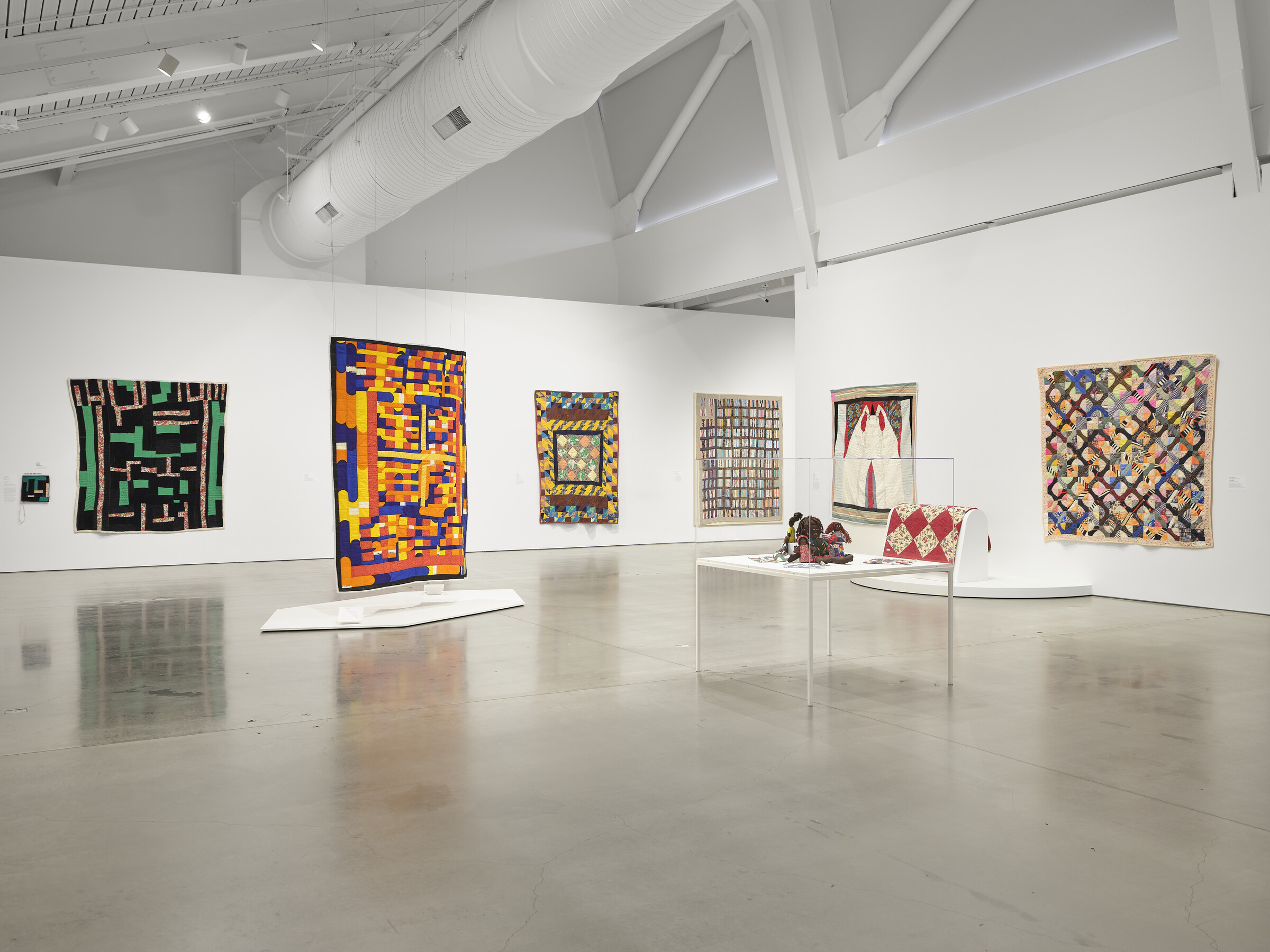
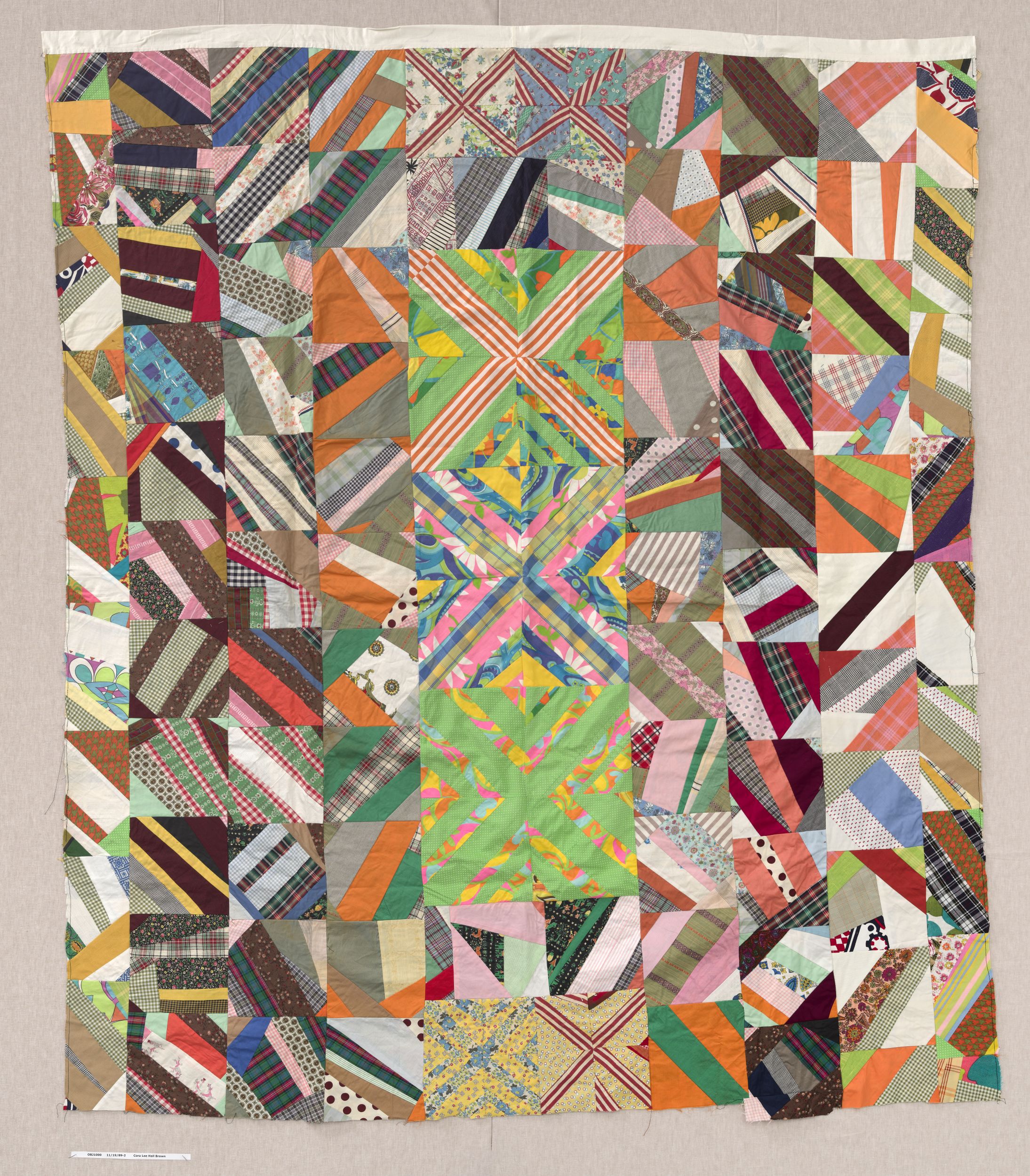
Many of the quilts and other textile works in Routed West did not inertly hang against the museum’s walls; instead, they were propped, draped, and suspended, allowing visitors to imagine them in the homes they once occupied and also experience them in the round (fig. 3). Cora Lee Hall Brown’s (1900–1981) Untitled Top (String Medallion with Newspaper Backing) (fig. 4) was shown in a display case, partially folded over to reveal its newspaper piecing on the back. The newspaper backing of the unfinished quilt would have eventually been removed, but its current state gave the viewer a sense of 1970s life through comics and grocery advertisements in the paper. In the same gallery, Isiadore Whitehead’s (1914–2005) Double Wedding Ring Room (c. 1970) also immersed the visitor in everyday life: The reconstructed Oakland guest bedroom included quilts, drapes, floor mats, and a seat cushion, all quilted using the challenging Double Wedding Ring pattern (fig. 5). Leon purchased the entire bedroom from Whitehead, even the furniture and jewelry bottles on the vanity. Whitehead was born in Arkansas and spent time in Louisiana before moving to the Bay Area in 1942, where she was a certified welder in the Richmond shipyards and earned a nursing credential.4 While working as a school bus driver, she received gifts of fabric from teachers and parents, which she used to adorn the room. Whitehead’s guest room, reassembled from photographs, chronicles community and friendship through the embroidered names of fabric contributors on her drapes.
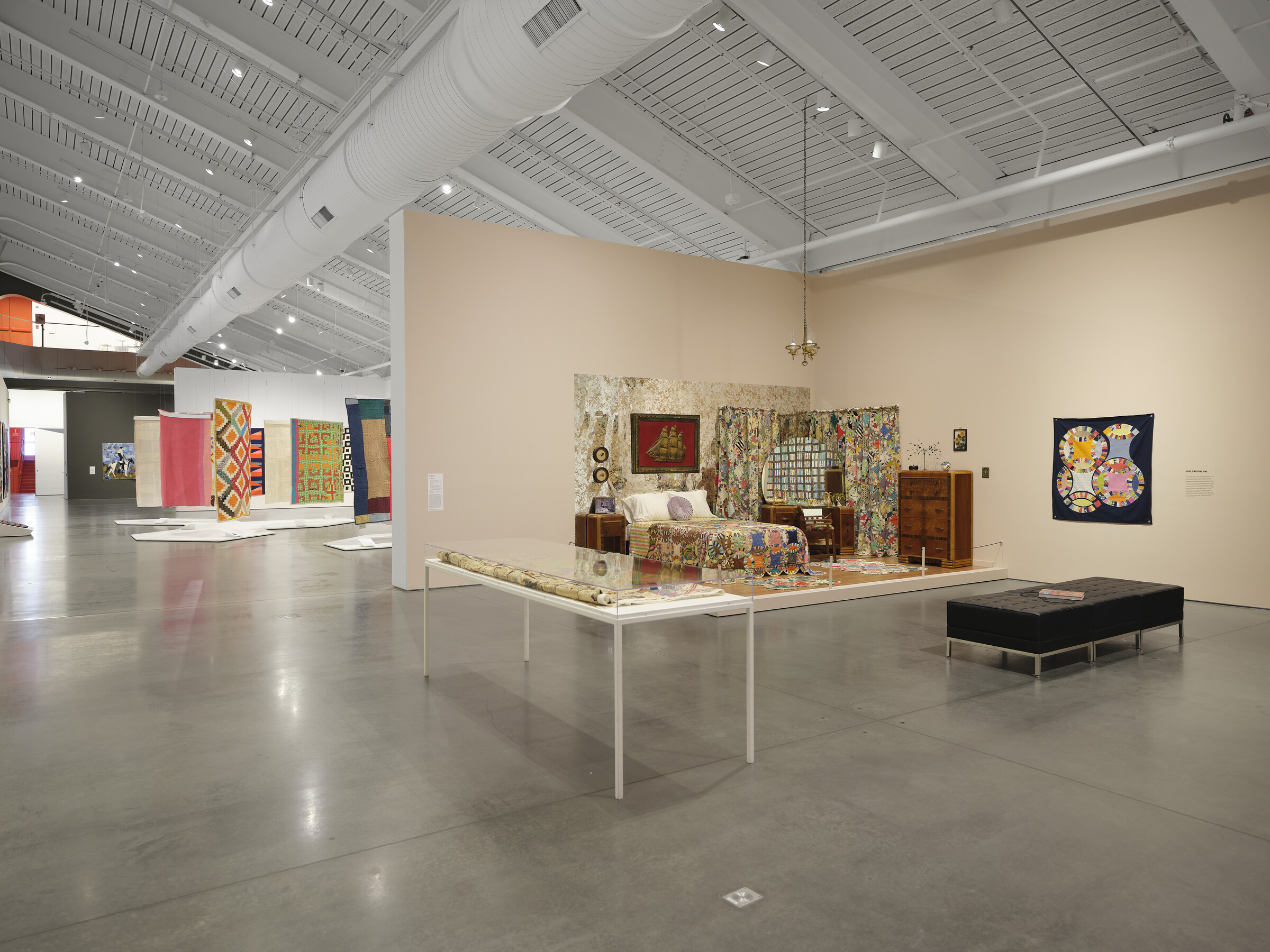
The collaboration involved in quilt making and quilt keeping mirrors the research efforts of Yau and curatorial associate Matthew Villar Miranda, who formed relationships with quilt artists and their surviving family members, making possible the valuable and nuanced narratives shared in the exhibition and its catalogue. This work was continued through exhibition programming like “Quilt Documentation Day,” an event where community members were encouraged to bring their family quilts to the museum to be photographed, documented, and recorded in the national African American Quilt Registry.5 A graduate student serves as the digital archivist for the African American Quilt Documentation Study Group, recording information from participants into the organization’s database. In fact, undergraduate and graduate students at the University of California, Berkeley, were engaged throughout the exhibition’s research and organization processes, pointing to Yau’s role as academic liaison.
The final section of the exhibition showcased the work of local individuals and collectives active today, such as the African American Quilt Guild of Oakland, the African American Shipyard History Quilt Project, and the Heritage Quilters Guild of Fresno. A display case of archival material showed publications, awards, and photographs vital to the efforts of sustaining African American quilt making traditions in California. Ora Clay (b. 1945), one of the artists included in this section, learned the practice of quilt making after retiring from her position as a school librarian and taking classes with expert quilter and National Endowment for the Arts–recipient Marion Coleman (1946–2019)at the Museum of the African Diaspora in San Francisco (MOAD). Both Clay and Coleman were represented by story quilts in Routed West, and they were featured in We Gather at the Edge: Contemporary Quilts by Black Women Artists (February 21–June 22, 2025), an exhibition recently organized by the Smithsonian American Art Museum and Renwick Gallery in Washington, DC.
Clay describes her inspiration for creating story quilts in an artist statement: “Quilting not only allows me to create beautiful art, working with different colors and textures, but also enables me to use the beauty of the quilting medium to draw the viewer into thinking about serious issues facing our world.”6 Clay’s My Migration (2025), displayed in the final gallery of Routed West, is repurposed from a quilt originally made by her mother, Minner Lampley. Lampley created the quilt in the early 1950s using Clay’s outgrown clothes and cotton from their family farm in Alabama. Clay brought the quilt with her when she traveled alone to California at the age of sixteen and used it for years, extending its life and narrative by transforming it into a story quilt that chronicled her migration. Representations of the Oakland Pullman train porters (who assisted her on her journey and helped her feel at ease), her own photograph, and the shoebox lunch that sustained her are stitched on top of Lampley’s heavily worn quilt, with its cotton batting partially revealed. In a way, the multigenerational layers of My Migration—its roots and routes—may serve as a symbol of the larger exhibition and its message that “each quilt carries with it a layered capacity to connect everyday experiences and environments to worlds of beauty, healing, remembrance, belonging, repair, renewal, legacy, building, and possibility.”
Cite this article: Berit Potter, review of Routed West: Twentieth-Century African American Quilts in California, Berkeley Art Museum and Pacific Film Archive, Panorama: Journal of the Association of Historians of American Art 11, no. 2 (Fall 2025), https://doi.org/10.24926/24716839.20590.
Notes
- Unless otherwise specified, the quotations cited in this review come from the exhibition texts. ↵
- Elaine Yau and Ora Clay, interview by Alexis Madrigal, “Quilt Exhibit at Berkeley Museum Chronicles Black Lives in California,” Forum, KQED, San Francisco, June 9, 2025, https://www.kqed.org/forum/2010101910195/quilt-exhibit-at-berkeley-museum-chronicles-black-lives-in-california. ↵
- Sarah Hotchkiss, “Rosie Lee Tompkins’ Mesmerizing Quilts on Grand Display at BAMPFA,” The Do List, KQED, May 28, 2021, https://www.kqed.org/arts/13898042/rosie-lee-tompkins-mesmerizing-quilts-on-grand-display-at-bampfa. ↵
- Matthew Villar Miranda and Elaine Y. Yau, “Quiltmaker Biographies,” in Routed West: Twentieth-Century African American Quilts in California, ed. Elaine Yau, exh. cat. (DelMonico Books, 2025), 252–53. ↵
- The African American Quilt Registry is an initiative of the African American Quilt Documentation Study Group and aims to “inspire understanding of the social, cultural, and artistic significance of American Quilts.” “About Us,” African American Quilt Documentation Study Group, accessed September 29, 2025, https://aaqdsg.com/about. ↵
- Ora Clay, “About,” Quilts‑by‑Ora, accessed July 26, 2025, https://www.quilts-by-ora.com/about. ↵
About the Author(s): Berit Potter is associate professor of art history and museum studies, Department of Art + Film, California State Polytechnic University, Humboldt.

